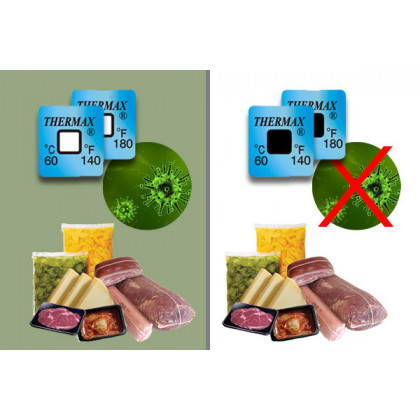The growth of bacteria in food is a serious public health problem. Bacteria and the enterotoxins they produce are the most common cause of food poisoning. Salmonella, as well as verotoxigenic Escherichia coli and Campylobacter, are some of the most common bacteria that cause poisoning.
The food industry establishes protocols for the correct treatment of food in to ensure its sanitary conditions when consumed. Making sure that these processes are carried out correctly is essential to prevent serious health problems. Using temperature indicators guarantees its correct implementation in an easy and affordable way.
Temperatures at which bacteria grow
Temperature is one of the factors that most affect the preservation of food, since bacteria may or may not develop depending on this variable. It should be noted that the presence of bacteria in food could also be beneficial. The main problems, however, arise due to the growth of these bacteria, which our body cannot handle. Therefore, the first thing we must check is the temperature at which bacteria grow most rapidly.
Bacteria reproduce at temperatures between 5 ºC and 60 ºC. Within this temperature range, and depending on other parameters like oxygen and the presence of water, we find the ideal conditions for bacteria growth.
We must bear in mind that bacteria commonly reproduce by binary fission and that this process can take place every 20 minutes. Therefore, in a short time, the bacteria population may have increased rampantly.
Killing bacteria with heat
One of the most widely used methods to preserve food in the food industry is the destruction of bacteria using heat. Most bacteria die at 65 °C and above. However, depending on the type of food or how it is to be stored, a temperature of 120 °C might be needed.
It is widely established that, if we keep food at 100 ºC enough time for all of its parts to reach this temperature, we will have killed any bacteria it contains.
Heat processes for the destruction of bacteria
With the increase of packaged foods and the need to extend their shelf life, while trying to maintain their organoleptic characteristics, we can currently find several methods to destroy bacteria:
Pasteurization: We heat the product to 75 ºC for 15 seconds. This process partially sterilizes the food, which must then be kept refrigerated. It is commonly used in products like cheese, milk, beer and even orange juice.
- Cooking: The aim is to keep the food at 80 ºC for 4 minutes. In principle, it destroys the bacteria, although some spores may remain. Depending on the specific food and type of bacteria, times and temperatures may vary.
- Sterilization: The food is heated to 120 ºC for 4 minutes. This process prevents the food from having to be kept refrigerated afterwards. It is frequently used in milk and fruit juices.
Temperatures to prevent bacteria reproduction
Another option used in the food industry is to keep food at a temperature that slows or even completely stops the growth of bacteria. As we have already indicated in this article, one of the main problems is not the presence of the bacteria itself, but its exponential increase inside the product.
Preserving food below 5 °C greatly reduces the reproduction of bacteria. Additionally, using vacuum packaging, removing oxygen, and keeping the food in a dry environment, are procedures that help to preserve it properly and prevent the growth of bacteria.
Freezing food at −18 °C completely stops bacteria growth and, in some cases, even destroys them. By freezing food, its shelf life is much longer without creating any health risks.
Temperature labels to control the destruction of bacteria
Heat processes to kill bacteria or to prevent them from reproducing are only effective if they are performed correctly. In this sense, it is essential to carry out control that ensures that we have achieved the indicated temperatures.
Irreversible temperature labels permanently change colour when the right temperature is achieved. This way, they control the heat processes and guarantee that the temperature at which the bacteria die has been reached. Therefore, they ensure that food complies with the preservation standards for consumption.
Similarly using adhesive temperature indicators is an effective way to monitor the cold chain, both for fresh and frozen products.

